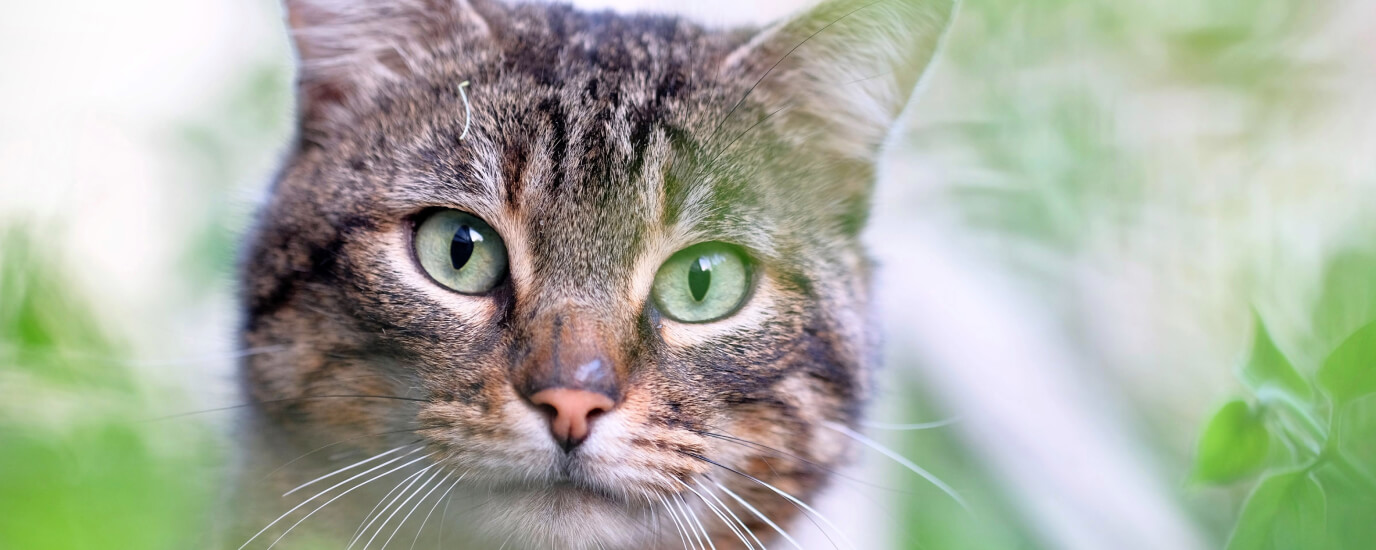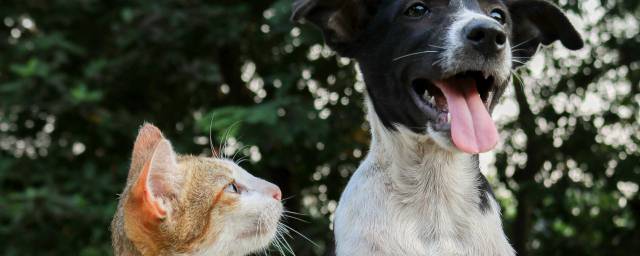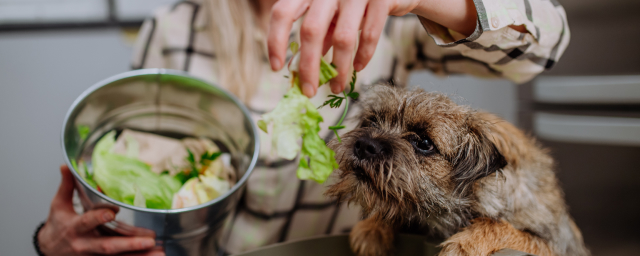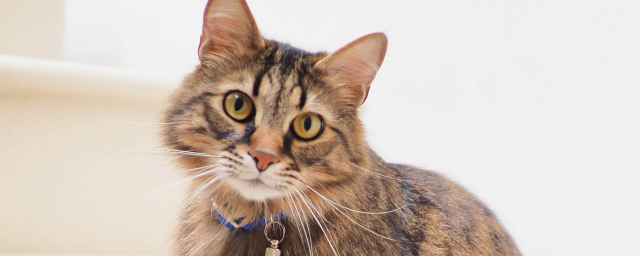
What Plants are Poisonous to Cats, Plus 10 Safe Options
Cats sniff and eat plants out of curiosity and exploration in your home. But, your cat doesn't always know the difference between good and bad plants.
Did you know that many common houseplants can be harmful to your pet? Whether in your home or in your yard, cat parents should keep their feline friends away from certain plants and flowers.
Here's everything a cat owner should know about poisonous flowers and plants including:
- 16 poisonous plants to avoid in your home
- Non-toxic plants that are safe for cats
- What to do if your cat gets into a toxic plant
- How to keep your cat out of plants at home
16 poisonous plants to avoid in your home
The toxicity of these plants depends on the plant material and chemical compounds, called saponins, in each plant. Here’s a list of flowers and plants cat owners should avoid having in their homes.
-
1. Aloe vera

Aloe vera is a popular plant to keep in your home for its healing properties and aesthetic look. Despite its popularity, aloe vera is toxic to cats.
The gel found inside the plant is edible when taken out. But, the thick plant material that surrounds the gel can cause digestive issues for your cat.
Lethargy and diarrhea are the most common symptoms in cats that ingest aloe vera. Even though it's not as dangerous as other plants, pet parents should still keep this plant out of reach for cats.
-
2. Autumn crocus (Saffron)

This plant is a common ornamental flowering plant that blooms in the fall. Autumn crocus can be found naturally in your backyard, but can also thrive as an indoor plant.
All parts of autumn crocus are highly toxic to cats and are also poisonous to dogs and horses. Cats that eat autumn crocus may show symptoms like:
- Diarrhea
- Vomiting
- Drooling
- Seizures
- Kidney failure
- Death
-
3. Azalea and rhododendron

Azaleas and rhododendrons (rhododendron spp.) are similar species of colorful flowering plant shrubs that are toxic to cats. If you have this species of plant in your yard, avoid bringing flowers or plant clippings into your home.
All parts of azaleas are toxic to cats, so don't let your cat come into contact with them. A cat can be poisoned by eating just a small amount. So, it's important to keep your cat away from azaleas to keep them safe.
-
4. Cyclamen

Also known as sowbread and Persian violet, cyclamen is often kept indoors. All parts of the cyclamen plant material contain saponins. This is a toxic component found in many flowers. So, cat parents should avoid keeping this houseplant in their homes.
Symptoms of cyclamen toxicity can include drooling, vomiting, and diarrhea when ingested in small amounts. In large amounts, it can be fatal for your cat.
-
5. Daffodil

This flowering spring perennial is not native to North America. But, it is one of the most common plants found in homes and gardens across the United States. The bulb of a daffodil is the most poisonous part of the flower. However, all parts of the plant contain a poisonous agent.
If a cat eats the poisonous agent called lycorine in a daffodil, they may experience drooling, vomiting, diarrhea, and abdominal pain. More serious symptoms include:
- Low blood pressure
- Difficulty breathing
- Convulsions
-
6. Dieffenbachia (Dumb canes)

Dieffenbachia is a common houseplant that is toxic to cats. This tropical flowering plant is also known as:
- Dumb cane
- Exotica perfection
- Tropic snow
Dieffenbachia contains insoluble calcium oxalates that can cause a skin reaction or irritation of your cat's mouth when ingested. Exposure to this plant can be painful and uncomfortable for cats.
-
7. Hyacinth

Hyacinths are bulbed flowers that grow naturally all over the United States. This makes them a popular spring plant for households and gardens. Cats can be poisoned by a Hyacinth plant by simply breathing its fragrance.
Hyacinth has a bitter taste to cats, due to its poison component that causes mouth irritation. Other symptoms of hyacinth poisoning include throat irritation, loss of kidney function, and difficulty swallowing or breathing.
-
8. Kalanchoe (Widow's-thrill)

Also known as the mother-in-law's tongue plant, the kalanchoe houseplant can cause stomach problems when ingested. Fatality is rare for cats that eat this flower. But, cat parents should keep this plant away from their pets to avoid health issues or allergies.
-
9. Lily

Many flowers contain "lily" in their name. But, the most poisonous species of lilies for cats include:
- Asiatic lilies
- Easter lilies
- Daylilies
- Japanese snow lilies
- Rubrum lilies
- Stargazer lilies
- Red lilies
- Tiger lilies
- Western lilies
- Wood lilies
These flowers are common plants for celebrations, especially in the spring. The entire plant is poisonous to cats. Even the pollen from the plant can cause kidney failure if inhaled by a cat.
VET TIP
Lilies are one of the most toxic flowers for cats. Seek veterinary care immediately if you find your cat eating or sniffing this poisonous plant.
-
10. Oleander (Nerium)

This plant is commonly found outdoors in warm climates. Oleander contains cardiac glycoside toxins that can damage the heart muscle in your cat if ingested.
All parts of the oleander flower are toxic. Even the water in a vase of these flowers can be toxic to your pet. So, pet parents should avoid keeping this plant in their yards and indoors.
Common symptoms of oleander poisoning include drooling, vomiting, diarrhea, seizures, tremors, and fatal heart problems.
-
11. Pothos (Devil's ivy)

This plant goes by a few different names, including:
- Pothos
- Devil's ivy
- Golden pothos
- Taro vine
This plant is commonly found in gardens and landscaping outdoors. But, devil’s ivy is also a common houseplant. Devil's ivy contains insoluble calcium oxalates that can cause mouth, throat, tongue, and lip irritation in cats.
-
12. Sago palm

The sago palm is naturally found in tropical and subtropical climates. But, it can also be kept indoors in colder regions. The seeds of this plant are the most dangerous for cats, but all parts are toxic.
Symptoms of sago palm poisoning include vomiting, diarrhea, bruising, lethargy, liver failure, and death. Seek immediate treatment if your cat eats any amount of sago palm.
-
13. Snake plant

The snake plant (sansevieria trifasciata) is a common plant to keep in your house because they are a low-maintenance plant. But, snake plants are toxic to cats and dogs.
Snake plants contain a toxic component called saponin. The more your cat ingests this component, the worse their symptoms will be. If a cat eats part of a snake plant, they will have a very bitter taste in their mouth.
Your cat may experience other symptoms like:
- Nausea
- Vomiting
- Diarrhea
- Excessive drooling
- Abdominal pain
- Swollen mouth and throat
Snake plant poisoning is not usually fatal for cats. But, pet parents should still contact their vet if their cat comes in contact with a snake plant.
-
14. Spanish thyme (Mexican mint)

Spanish thyme can poison your cat through contact or ingestion. Spanish thyme contains essential oils that can burn your cat's skin if touched or damage your cat's health if ingested.
Spanish thyme has healing properties for humans. But, pet parents should keep this plant out of their homes for their cat's best interest.
If your cat comes into contact with Spanish thyme, call your veterinarian immediately. The essential oils in Spanish thyme can absorb into your cat's system and make them ill quickly.
-
15. Tulip

Tulips are in the same plant family as hyacinths and lilies. All parts of the tulip plant material are toxic to cats, but the bulbs of these colorful flowers are especially poisonous.
Because tulips are the same species as hyacinth, the symptoms of poisoning are the same. If your cat ingests part of a tulip, they may experience excessive drooling, vomiting, diarrhea, depression, and tremors.
-
16. Yew (Taxus)

Yew is an evergreen shrub commonly found outdoors in landscaping. This shrub is extremely poisonous to cats, dogs, horses, cattle, birds, and humans.
All parts of this plant are poisonous to all species. So, it's important for pet parents and pets alike to avoid contact with yew. Yew can cause severe symptoms in cats if eaten, like muscle tremors, seizures, and cardiac failure.
VET TIP
If your cat ingests one of these poisonous plants, contact your vet. They can help you calm any clinical signs and avoid further harm.
Non-toxic plants that are safe for cats

Many common houseplants are toxic for your furry friend. But, there are many plants that are safe for pet parents to keep in their homes and outdoors.
-
African violet
African violets are great colorful flowering houseplants that can replace poisonous flowers like oleander and cyclamen. This plant needs indirect sunlight to bloom and thrive.
-
Calathea orbifolia
This leafy plant needs partial shade to survive, making it a great option for a shelf or plant stand. Calathea is a great alternative to the snake plant. But it isn't poisonous to cats (like snake plants).
-
Chinese money plant
The Chinese money plant (good luck plant) is non-toxic and is part of the Pilea genus family. This plant offers the same drooping aesthetic as Ivy and is a safe alternative to keep in your home.
-
Ferns
Safe options for ferns in your home include:
- Boston ferns
- Bird's nest ferns
- Staghorn ferns
The bird's nest fern thrives in low light and varying humidity conditions, making it a great, safe addition to a bathroom.
-
Gloxinia
Gloxinia is another colorful plant that is safe for homes with pets. These flowers have a juicy leaf structure that thrives in direct sunlight.
-
Orchid
Orchids are a common plant for vases and bouquets in the United States. Orchids are safe for cats and can last up to four months with proper care.
-
Palms
Some palms are toxic for cats, however, date palms, parlor palms, and ponytail palms are safe alternatives. Plus, they provide the same tropical vibes as other houseplants and only need a few hours of indirect light per day.
-
Rattlesnake plant
Rattlesnake plants can brighten a room with their colorful flowers and rich green foliage. Like other plants, rattlesnake plants thrive out of direct light indoors.
-
Spider plant
The spider plant is a simple plant for pet parents. It has rich foliage that also serves as an air purifier to rid your home of toxins. These plants are easy to grow indoors and are a great alternative for cats.
-
Venus flytrap
This pet-friendly plant is a great option if you're looking for other plants that mimic succulents. Venus flytraps need four hours of direct sunlight and a supply of distilled water.
What to do if your cat gets into a toxic plant

Toxicity in cats can vary from mild to severe. But, it's important for cat parents to act quickly if their pet comes in contact with a poisonous plant. If you believe your cat ate or inhaled a poisonous plant, don't wait to take action.
Here are two choices if your pet comes in contact with a poisonous houseplant:
1. Call the pet poison helpline.
The pet poison helpline is a helpful resource for cat owners. They can help you if you've witnessed your cat eating a potentially poisonous plant or notice minor symptoms. They will ask questions about the plant, your cat's exposure, and their symptoms.
Their top priority is stabilizing their patient's health, even if your cat isn't acting overtly sick. They may provide guidance for controlling clinical signs. This may include giving hydrogen peroxide to your cat to induce vomiting.
For immediate emergency treatment call the Pet Poison Helpline at 800-213-6680.
2. Seek immediate veterinary treatment.
The best plan of action is to seek emergency treatment from a vet. If your cat eats a toxic plant, they could experience symptoms like:
- Excessive drooling
- Abdominal pain
- Diarrhea
- Dermatitis
- Difficulty swallowing
- Difficulty breathing
- Kidney failure
At the hospital, your vet might induce vomiting by giving hydrogen peroxide to your cat. They may also start intravenous fluid therapy. Intravenous fluids (IVs) and supportive fluid therapy options are good options for most cats with plant poisoning.
Your vet may also prescribe medicine to control clinical signs like diarrhea or pain. Anti-diarrhea medication is a common supportive treatment for plant poisoning.
How to keep your cat out of plants at home

The best way to protect your cat from a poisonous plant is to keep them out of your home altogether. But, there are ways you can safely keep these plants away from your kitty to keep them happy and healthy.
1. Keep flowers and plants out of reach.
Plants that are poisonous to cats should be kept out of reach from your pets. Keeping them in a secluded room or up on a high shelf can help separate your feline friend from the plant.
2. Make your plants unappealing.
Cats do not enjoy eating or smelling citrus. Pet parents can use diluted lemon, lime, or orange juice to spray on plants they want their pets to avoid.
3. Train your cat to leave plants alone.
Cats can be trained to leave plants alone. But, it takes patience and consistency. Incorporate this type of training with your cat's trick training to teach them to stay away from plants.
Protecting your pets from the dangers of poisonous flowers and plants is an important part of being a pet parent. Knowing which plants are safe and what to do if your pet comes into contact are great first steps.
Cat check-ups aren't just for medical emergencies (like exposure to a potentially toxic plant). They are important for all kinds of cat health problems. Explore everything you need to know about scheduling a cat check-up.
KEEP READING

